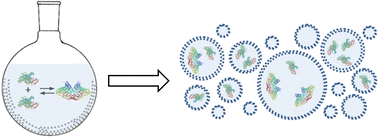Statistical predictions on the encapsulation of single molecule binding pairs into sized-dispersed nanocontainers†
Abstract
Single molecule experiments have recently attracted enormous interest. Many of these studies involve the encapsulation of a single molecule into nanoscale containers (such as vesicles, droplets and nanowells). In such cases, the single molecule encapsulation efficiency is a key parameter to consider in order to get a statistically significant quantitative information. It has been shown that such encapsulation typically follows a Poisson distribution and such theory of encapsulation has only been applied to the encapsulation of single molecules into perfectly sized monodispersed containers. However, experimentally nanocontainers are usually characterized by a size distribution, and often just a single binding pair (rather than a single molecule) is required to be encapsulated. Here the use of Poisson distribution is extended to predict the encapsulation efficiency of two different molecules in an association equilibrium. The Poisson distribution is coupled with a log-normal distribution in order to consider the effect of the container size distribution, and the effect of adsorption to the container is also considered. This theory will allow experimentalists to determine what single molecule encapsulation efficiency can be expected as a function of the experimental conditions. Two case studies, based on experimental data, are given to support the theoretical predictions.



 Please wait while we load your content...
Please wait while we load your content...